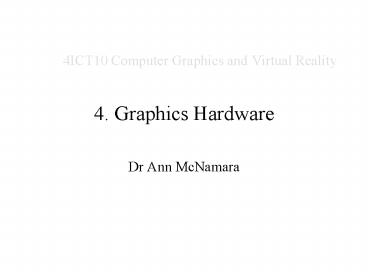4ICT10 Computer Graphics and Virtual Reality - PowerPoint PPT Presentation
1 / 16
Title:
4ICT10 Computer Graphics and Virtual Reality
Description:
A frame buffer may be thought of as computer memory organized as a two ... requires a fixed palette of colours. Flat Panel Displays. Summary ... – PowerPoint PPT presentation
Number of Views:281
Avg rating:3.0/5.0
Title: 4ICT10 Computer Graphics and Virtual Reality
1
4ICT10 Computer Graphics and Virtual Reality
- 4. Graphics Hardware
- Dr Ann McNamara
2
Frame Buffers
- A frame buffer may be thought of as computer
memory organized as a two-dimensional array with
each (x,y) addressable location corresponding to
one pixel. - Bit Planes or Bit Depth is the number of bits
corresponding to each pixel. - Typical frame buffer resolution
- 640 x 480 x 8
- 1280 x 1024 x 8
- 1280 x 1024 x 24
3
Typical Raster System Architecture
4
(No Transcript)
5
The Scanning Process
6
Colour Display System
7
24-bit Raster, No CLUT
In this case the value sent to the display is
the value in the pixel.
Each pixel requires 24-bits
8
8-bit Raster with 24-bit CLUT
Each pixel requires 8-bits
9
Colour LUT
10
Comparing Two Systems
11
Display Characteristics
- 2D Graphics displays are characterised by
- resolution number of independent pixels (e.g.
1024 ? 768) - colours/bits per pixel (e.g. 24bit ? 224 colours
16,777,216) - dot pitch no. of phosphors per inch. (dpi)
- refresh rate (Hz.)
- interlaced / non-interlaced
- phosphor wavelengths (nm.)
- these are usually specified using chromaticity
values - whitepoint (K)
- some monitors allow you to change the whitepoint
12
Broadcast Standards
- European (except France) TV (PAL), introduced in
1960 - Phase Alternating Line
- frame rate 25 Hz. and field rate 50 Hz.
- 625 scan lines
- US Japanese TV (NTSC), introduced in 1953
- National Television System Committee (or Never
The Same Colour) - frame rate 29.97 Hz. and field rate 59.94 Hz.
- 525 scan lines
- Both TV systems use interlacing.
13
Display Memory Bandwidth
- CRT electron guns receive an analogue voltage
signal from DACs, 1 per colour channel. - Most current DACs are 8-bit per channel.
- ? 24 bits per pixel required
- 224 possible colours 16777216
- (humans can see many more than this!)
- Bandwidth requirements for a typical graphics
system - Resolution 1024 ? 768
- Refresh rate 75 Hz. non-interlaced
- 24 bits per pixel
? 176,947,200 bytes/sec. transfer required ? RAM
access time ? 5.65 ns.
14
Solutions
- Use faster RAM VRAM
- Video RAM (dual ported)
- CPU and DACs can access RAM simultaneously
- no need for DMA or CPU latency
- more expensive than standard DRAM
- Reduce bandwidth
- use Colour LookUp Tables (CLUT)
- this is becoming very popular in systems using
texture mapping it reduces the total memory
requirements for textures ? CLUT per texture - reduces memory per pixel
- total storage costs are now down, but slight
increase in latency due to CLUT lookup, but this
is usually negligible - requires a fixed palette of colours
15
Flat Panel Displays
16
Summary
- Basic Components of BW and Colour CRTs
- The relationship between elements in the frame
buffer and pixels on the display - Display Characteristics
- Colour LookUpTables































